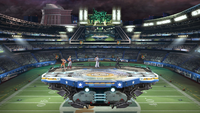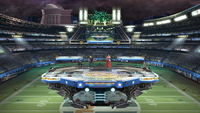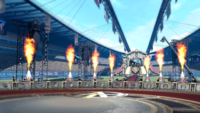King of Fighters Stadium
| Fatal Fury King of Fighters Stadium | |
|---|---|
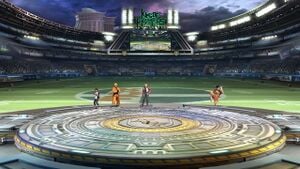 
| |
| Universe | Fatal Fury |
| Appears in | Ultimate |
| Availability | Downloadable |
| Crate type | Normal |
| Maximum players | 8 |
King of Fighters Stadium (KOFスタジアム, KOF Stadium) is a downloadable stage for Super Smash Bros. Ultimate. It was released on November 6th, 2019 as part of Challenger Pack 4, being the home stage of Terry. The stage is a large arena themed around the King of Fighters tournament, which was featured in the Fatal Fury series before branching out into its own series with the same name.
Stage overview
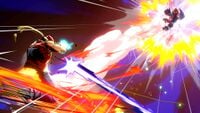
The stage's layout is a simple flat ring, similar to most stages in the Fatal Fury and The King of Fighters series, which is slightly elevated above ground level. It takes place in a large, arena-like stadium close to the center of a gridiron football field. Similar to both Pokémon Stadium and Boxing Ring, a large jumbotron that records the on-screen action can be seen in the background. Invisible walls are on both sides of the stage, blocking the respective blast lines; these walls can be broken by dealing enough knockback to a fighter, akin to the shields in Home-Run Contest from Brawl onwards. However, fighters can still be knocked into the vertical blast zones with enough knockback.
In addition to the invisible walls of the side, there is also an invisible ceiling above the upper blast zone, which prevents players from getting over the walls, as technical limitations prevent them from having an infinite height.
Background characters from Fatal Fury and The King of Fighters make cameos just outside of the ring, similarly to how they do while watching the fight in the early The King of Fighters games. There are 20 in total, but only three or four will appear in a single match. While they are normally random, the choice of music will guarantee specific characters to appear. If there are more than four players in a match, no characters will appear.
Several additional effects occur whenever a player scores a KO: the crowd cheers, background characters react, smoke machines on the football field deploy multicolored smoke trails, sparklers on the arena activate, and the "King of Fighters" logo above the jumbotron lights up in multiple colors.
Hazards off
No changes are made when hazards are turned off.
Ω form and Battlefield form
The Ω form and Battlefield form are set far above the ground overlooking the field. The main platform resembles the ring of the normal form, but resized and reshaped to match Final Destination and Battlefield, respectively. The three soft platforms of the Battlefield form are metallic and are unique to this form. The invisible walls of the normal form are removed in keeping with the stages of their respective forms. The character cameos remain present in both forms, appearing in the background of the main platform. The additional effects that occur after a KO remain in both forms.
Background characters
The following characters cameo in the background of the stage.
Fatal Fury
- Andy Bogard - Briefly bends one leg against the other and flips his hair, then flashes a smile with a thumbs up. His design is based off of his original appearance in the early Fatal Fury and The King of Fighters games.
- Joe Higashi - Throws out a pair of two rapid punches before raising his fist victoriously and striking a pose with his leg raised. His design is based off of his original appearance in the early Fatal Fury and The King of Fighters games.
- Geese Howard - Stands with his arms crossed, frequently laughing. His design is primarily based on his outfit from Fatal Fury: King of Fighters, however his white shirt is folded down to his waist with his hakama, much like Fatal Fury Special and The King of Fighters from '96 onwards.
- Billy Kane - Sets his signature staff standing up beside him, briefly twirling it and setting it on his shoulder before returning it to its' original position. His appearance derives from Real Bout Fatal Fury and The King of Fighters '97 onwards.
- Rock Howard - Briefly gives a thumbs up before setting his hand at his side. He will occasionally charge chi in his hand before briefly falling limp, exhausted. This is based on his victory pose in Garou: Mark of the Wolves whenever he finishes a round with Raging Storm or Neo Deadly Rave. His appearance is based on The King of Fighters XIV with the "Keep the Faith" slogan on the back of his jacket.
- Tung Fu Rue - Strokes his beard with one hand, frequently alternating the hand used while occasionally nodding. His design is taken from Fatal Fury: King of Fighters and Fatal Fury Special.
- Kim Kaphwan - Reels back with his fists pumped to his side before setting them both on his hips. His design is based off of every appearance he has made in The King of Fighters series.
- Blue Mary - Performs a finger gun motion with a wink before slightly turning her back and blowing a kiss. Her design is taken from The King of Fighters XIV.
- Ryuji Yamazaki - Keeps his hands tucked in his pockets, occasionally taking both of them out to maniacally laugh. His design is taken from The King of Fighters XIV.
Art of Fighting
- Ryo Sakazaki - Quickly raises a victorious hand in a manner similar to Joe before leaning forward with a pumped fist and a grin. His design is primarily based on his appearances in the original Art of Fighting and the early The King of Fighters games.
- Yuri Sakazaki - Cheers by raising her fist, throwing out two punches, and jumping with both of her hands creating a peace symbol. Her design is taken from virtually every appearance she makes, retaining a more subdued color scheme like that in The King of Fighters series. She has long braided hair, like in the games before The King of Fighters XIII.
- King - Slightly turns her shoulder and gives a thumbs up, occasionally twirling her arm and holding out her open palm. Her design primarily takes from The King of Fighters XIV.
The King of Fighters
- Kyo Kusanagi - Briefly showcases a small flame in his open palm before closing it shut and pumping his fist victoriously. His design is based off of his iconic Rugal/Orochi saga outfit in the early The King of Fighters games.
- Iori Yagami - Waves his hand with his signature purple flames creating a trail, closing his hand and turning his back to the screen. His design derives from virtually every appearance he makes, with the exception of The King of Fighters XII and The King of Fighters XIV.
- Goro Daimon - Stands with his arms crossed, frequently nodding. His design is based on every appearance he has made.
- Chang Koehan - Raises and waves his signature ball and chain in a rhythmic motion. His design is primarily based on his appearances in The King of Fighters '94 and The King of Fighters '95.
- Choi Bounge - Hops around on alternating feet before pressing his wrists together and performing a slithering-esque dance. Much like Chang, his design is based on his appearances in the first two The King of Fighters games.
Psycho Soldier
- Athena Asamiya - Performs two different cheering poses: one where she spins and stands on one foot with a peace symbol against her eye, and another in which she jumps onto one foot and raises her hand. Her design is based on The King of Fighters '95 and Capcom vs. SNK 2.
Ikari Warriors
- Ralf Jones - Punches his open palm before pumping his fists. His design is taken from the early The King of Fighters games, as well as his appearance in Metal Slug.
- Clark Still - Holds onto the tip of his hat, occasionally raising both his hands in a cheering motion. Much like Ralf, Clark's design is taken from the early The King of Fighters games and Metal Slug.
Cameos for specific music
During the "Mr. Sakurai Presents Terry Bogard" video, Masahiro Sakurai notes that some character cameos will always appear depending on the music track that is playing. The following is a list of confirmed cameos with accompanying music.
| Song | Cameo |
|---|---|
| Soy Sauce for Geese - FATAL FURY SPECIAL Soy Sauce for Geese - KOF XIV |
Geese Howard |
| Pasta - FATAL FURY 2 | Andy Bogard |
| A New Poem That the South Thailand Wants to Tell - FATAL FURY 2 | Joe Higashi |
| Let's Go to Seoul! - FATAL FURY 2 | Kim Kaphwan |
| The London March - FATAL FURY 2 | Billy Kane |
| Ne! - KOF '94 | Yuri Sakazaki, King, Blue Mary |
| DESERT REQUIEM ~Operation02UM~ - KOF 2002 UM W.W.III - KOF XIV IKARI - KOF XIV |
Ralf Jones, Clark Still |
| ESAKA!! - KOF 2002 UM Esaka Continues... - KOF XIII Yappari ESAKA - KOF XIV |
Kyo Kusanagi, Goro Daimon |
| Stormy Saxophone 2 - KOF '96 | Iori Yagami |
| New Order - KOF XIV | Kyo Kusanagi, Iori Yagami |
| Tame a Bad Boy - KOF XIII | Kim Kaphwan, Chang Koehan, Choi Bounge |
| Forest World - Athena Psycho Soldier Theme Psycho Soldier Theme (Overseas Version) |
Athena Asamiya |
| ART of FIGHT - Art of Fighting Art of Fighting Ver.230000000.0 - FATAL FURY SPECIAL |
Ryo Sakazaki, Yuri Sakazaki |
Origin
Rather than being a stage based on Terry, such as his iconic Transcontinental Railroad stage, King of Fighters Stadium is an original design based on the various arenas from The King of Fighters series. Its overall open-field design, muted metallic tone, and design of the stands along with the jumbotron bearing the King of Fighters logo, most prominently resembles a mixture of the Stadium stage from XII and the Antonov Super Arena from XIV. However, the bold green design of this logo is completely original to Smash, and the circular design of the main platform appears closest to Kagura Stadium from '96, including the "KOF" logo in the center, which has a Smash logo in place of the "O". While these stadium stages in The King of Fighters series all appear to be dedicated venues for fighting tournaments, the one seen in Smash is an adapted American football stadium.
The layout of the stage is designed after a traditional fighting game like the Fatal Fury series, where the layout is flat and even, and ringouts are uncommon. The breakable walls are inspired by Real Bout Fatal Fury, which features a similar mechanic; in that game, however, the walls permanently break after enough damage, and they are usually not invisible. The stage's day/night cycle is a reference to a similar effect many stages in the Fatal Fury and The King of Fighters series go through, namely shifting from day to dawn to night (not always in this order) as rounds begin and end.
"King of Fighters" is a recurring tournament in SNK's gaming universe. The concept was first introduced in Fatal Fury: King of Fighters, although canonically, the first time a King of Fighters tournament was ever held was in Art of Fighting 2. Recently, the tournament's most prominent appearances are in The King of Fighters series, which was based on the idea developed in both series, as well as Ryo Sakazaki's appearance as a secret extra opponent in Fatal Fury Special.
Gallery
Terry using Burning Knuckle on the stage, with Clark Still, Ryo Sakazaki and Kim Kaphwan in the background (left to right).
Terry air dodging with Joe Higashi, Iori Yagami and Andy Bogard in the background (left to right).
Terry attacking Link, Villager and Falco with Power Geyser, with Choi Bounge, Billy Kane and Chang Koehan in the background (left to right).
Trivia
- This is the only stage in the game on which it is not possible to self-destruct by crossing the side blast zones.
- King of Fighters Stadium is based on stadiums that appear in The King of Fighters series, which makes it one of eight stages in the Super Smash Bros. series to be featured as a stage in other fighting games, the others being the Fountain of Dreams, Green Hill Zone, Pyrosphere, Suzaku Castle, Midgar, Dracula's Castle and Spring Stadium. Of these, King of Fighters Stadium, Suzaku Castle and Spring Stadium are the only ones that originate from a fighting game.
- However, it is worth noting that King of Fighters Stadium is an amalgamation of several stages that have appeared in The King of Fighters games, and not an actual location featured in the series.
- To the right of the stage, there is a banner that reads "Welcome to Super Smash Bros. Ultimate", which features a special King of Fighters logo where the Super Smash Bros. logo serves as the "O" in KOF.
- Banners in the background include the logos for Alpha and Arex—recurring brands in the King of Fighters series—as well Fatal Fury and King of Fighters themselves, many of which incorporate the Smash logo. One banner reads "Neo Challenger", as a reference to both the Neo Geo and Terry's status as a newcomer to Smash, and another is SNK's logo edited to read "SSB".
- Mai Shiranui, despite being as prominent a character as Terry in the Fatal Fury and The King of Fighters series, does not make a cameo appearance on the stage. According to Sakurai, Mai was excluded in order to keep the game's A rating from the CERO.
- The back of Billy's jacket, alongside his No Smoking symbol, has text that reads "The Future Is Now", which is SNK's slogan. This slogan is also found on some of the banners in the background of the stage.
- The designs of background characters encompass a variety of different games throughout their history; King, Yamazaki, Rock, and Blue Mary, for example, are the only characters to use their updated designs from The King of Fighters XIV, while Athena, Chang, Choi, and the Ikari Warriors use their older designs from The King of Fighters '94 and '95.
- In 8-Player Smash or Mob Smash, no background characters will appear.
- Super Mushrooms and Lightning bolts, which both notably have the ability to make a fighter giant, can't spawn on this stage.
- The idle and cheering animations that the background characters have are based on their background animations in The King of Fighters series during a match and when the player wins a round, respectively. However, some characters have had theirs significantly altered, such as Chang and Choi while some have poses based on entirely different games, most notably Rock.
- Goro is the only background character who does not appear in Terry's congratulations screen for his classic route.
- The following Assist Trophies cannot appear on this stage: Thwomp, Chef Kawasaki, Andross, Tiki, Kapp'n, Devil, Dr. Wright, Flies & Hand, Isaac, Dr. Kawashima, Arcade Bunny, Squid Sisters, Ghosts and Wily Capsule. Additionally, the following Poké Ball Pokémon cannot be summoned: Abra, Alolan Exeggutor, Staryu, Eevee, Scizor, Gardevoir, Kyogre, Giratina, Oshawott, Genesect, Fletchling, Gogoat, Bewear, Pyukumuku, Mimikyu, Lunala and Marshadow.
- This is the largest amount of Pokémon that cannot be summoned on a single stage.
- While it is possible to tech on the invisible wall, it is not possible to wall jump, wall cling, or grapple with Green Missile, Dragon Lunge, and Sword of the Creator. Additionally, as with the Home-Run Stadium, the wall is not always attached to the blast lines; should Sudden Death occur, the blast lines will eventually placed inside the wall.[1]
- Although not visible in-game, King's bra can be seen in her textures. This bra is a reference to the original Art of Fighting, in which by destroying her clothes by winning against her with a special move, she would admit to being a woman.
References
|
| |
|---|---|
| Fighter | Terry (SSBU) |
| Stage | King of Fighters Stadium |
| Related | Iori Yagami · Nakoruru · Ryo Sakazaki |
| Spirits | Spirits |
| Music | Ultimate |
